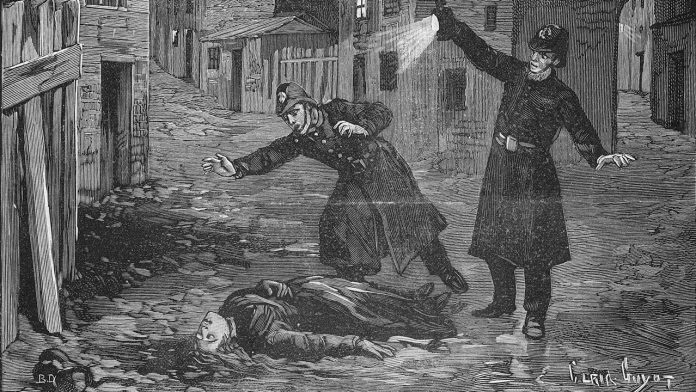Jack the Ripper—the name alone evokes fear, fascination, and endless speculation. This unidentified serial killer terrorized the streets of London’s Whitechapel district in 1888, brutally murdering at least five women. Despite extensive investigations over the past century, his identity has remained a chilling mystery. However, recent advancements in DNA technology have sparked new claims that Aaron Kosminski, a 23-year-old Polish barber, was the infamous killer. But does the evidence truly solve this age-old mystery?
The Shawl: Key Evidence or Contaminated Artifact?
The case for Kosminski hinges on a single piece of evidence: a stained silk shawl purportedly found at the scene of Catherine Eddowes’ murder. Eddowes, believed to be Jack the Ripper’s fourth victim, was murdered in September 1888. The shawl is said to bear traces of blood and semen—the latter presumably belonging to the killer. But the shawl’s authenticity is highly contested.
Critics question whether the shawl was ever present at the crime scene. Police reports from the time do not mention the shawl, and it was allegedly kept in private hands for years before resurfacing in 2007 when it was bought by author Russell Edwards. Over such a long period, the shawl could have been contaminated, making it difficult to trust any DNA findings.
How DNA Analysis Identified Kosminski
Despite concerns about contamination, forensic scientists Jari Louhelainen and David Miller published a study in the Journal of Forensic Sciences in which they claimed to have extracted mitochondrial DNA from the shawl. Mitochondrial DNA (mtDNA) is inherited solely from one’s mother and can be used to establish maternal lineage. The scientists compared the mtDNA from the shawl to samples taken from living descendants of both Catherine Eddowes and Aaron Kosminski. According to their findings, the DNA from the shawl matched Kosminski’s maternal line, suggesting he could be the killer.
Louhelainen and Miller also claimed that the analysis revealed the suspect had brown hair and brown eyes, which matched witness descriptions at the time. However, while such traits may seem helpful, they are not unique. Many people in Victorian London had brown hair and eyes, meaning this evidence alone cannot conclusively identify Kosminski.
Privacy Concerns and Missing Data
One of the most significant criticisms of the study is the lack of transparency. The researchers did not publish the full mitochondrial DNA sequences, instead using simplified visual graphics to show the matches between the shawl’s DNA and modern-day descendants. Louhelainen and Miller argued that privacy laws in the U.K. prevent them from sharing genetic data of living relatives. However, many forensic experts disagree, pointing out that mitochondrial DNA does not reveal sensitive personal information and is routinely shared in scientific studies.
Without full access to the data, other researchers cannot verify the findings. Walther Parson, a forensic scientist at Innsbruck Medical University in Austria, expressed concern, stating that withholding data undermines the scientific process. “Science relies on transparency,” he said. “If the results cannot be independently confirmed, they remain open to doubt.”
The Limitations of Mitochondrial DNA
Another critical issue is the inherent limitations of mitochondrial DNA testing. Unlike nuclear DNA, which is unique to each individual, mitochondrial DNA is shared among all members of a maternal lineage. This means that many people—potentially thousands—could share the same mitochondrial DNA profile as Kosminski. As mitochondrial DNA cannot be used to identify individuals with absolute certainty, it is more useful for ruling suspects out than definitively naming them as the culprit.
Hansi Weissensteiner, an expert in mitochondrial DNA, emphasized this limitation. “Mitochondrial DNA can only exclude suspects,” he explained. “While the shawl’s DNA may be consistent with Kosminski’s maternal line, it could just as easily match thousands of others who lived in London at the time.”
Kosminski: A Longtime Suspect
The theory that Aaron Kosminski was Jack the Ripper is not new. Kosminski was a known suspect during the original investigation in 1888. Police at the time described him as mentally ill, and he reportedly expressed violent hatred toward women. Some officers believed Kosminski was responsible for the murders, but there was not enough evidence to arrest him. He was eventually committed to an asylum, where he spent the rest of his life.
Author Russell Edwards revived the Kosminski theory in 2014 when he published the book Naming Jack the Ripper. Edwards claimed that Louhelainen’s preliminary DNA analysis of the shawl proved Kosminski’s guilt. However, the study had not yet been peer-reviewed at the time, leading many experts to dismiss the book’s conclusions.
Other Theories and Competing DNA Claims
The recent DNA analysis is not the first attempt to identify Jack the Ripper using genetic evidence. In the early 2000s, crime author Patricia Cornwell commissioned DNA testing on letters supposedly sent by the Ripper to the police. Based on the results, she accused the painter Walter Sickert of being the killer. However, many historians believe the letters were hoaxes, casting doubt on Cornwell’s theory.
In another unusual twist, a separate DNA analysis of the same letters suggested the murderer could have been a woman. However, this theory was quickly dismissed due to a lack of credible evidence.
Can We Ever Know the Truth?
The mystery of Jack the Ripper remains one of history’s most enduring unsolved cases. While modern forensic techniques offer new possibilities, they also come with limitations. The latest DNA findings linking Aaron Kosminski to the murders are intriguing but far from definitive. Without more transparent data and uncontaminated evidence, it is unlikely that the case will ever be officially closed.
For now, the identity of Jack the Ripper remains shrouded in mystery—a grim reminder of London’s dark past and a puzzle that may never be solved.
